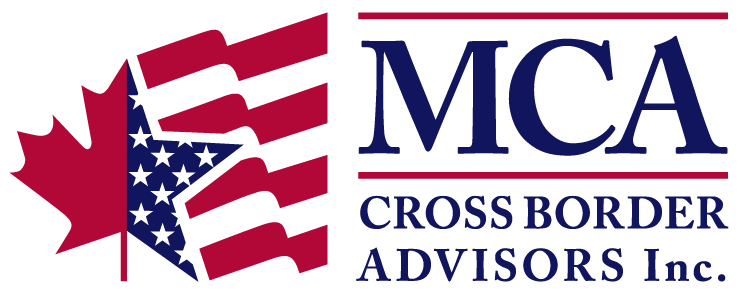Professor Relocating
to the US
Unfortunately for Canada, a lot of our best talent gets recruited to the US. This “brain drain” phenomenon frequently occurs in the field of academia as Canadian professors move south to take advantage of the larger number and variety of professorial positions available in the US compared to Canada. Some Canadians also want to stay in the US after completing their doctoral degrees south of the border.
For Canadian professors who move to the US for only a short term , such as a postdoctoral fellowship position, questions arise regarding tax residency. Are such professors tax residents of Canada or the US? What about professors who move for a permanent position at a US college or university?
In addition to questions surrounding cross-border tax, Canadian professors moving to the US may also have immigration questions; for example, what is the ideal US visa? Popular US visas for Canadian professors include the J-1, H-1B, and TN. Each of these visas comes with its own set of advantages and disadvantages. Pursuing the appropriate visa from the outset is important, especially if Canadian professors ultimately desire permanent residency in the US – not all visas allow for a seamless transition to obtaining a Green Card.
Which US retirement account to open is yet another question faced by Canadian professors moving to the US, who typically require guidance on US retirement plans such as the 403(b) and the 457.
As the above questions illustrate, making the decision to move to the US necessitates careful pre-departure tax, immigration, and retirement planning. Canadian professors relocating to the US must also be familiar with potential cross-border tax filing requirements, US estate planning and investment opportunities, and how to obtain optimal health insurance coverage for themselves and their families.
Keep reading for more information about these cross-border financial planning topics as they apply to Canadian professors who are moving to the US. Please note that the topics covered below require detailed, comprehensive analysis before specific recommendations can be made to an individual client, which is the purpose of creating a cross-border financial plan prior to departure.
- Tax Planning
- Estate Planning
- Retirement Planning
- Investment Planning
- Health Coverage & Insurance
- Tax Filing Requirements
- Immigration
Residency
Canada and the US each have strict domestic rules regarding tax residency. Under each country’s domestic tax laws, snowbirds who spend most of their time in the US but continue to live in Canada for part of the year might find themselves being tax residents of both countries simultaneously. This is not an ideal situation as it increases the chance that a snowbird will be exposed to double taxation. It is therefore preferable to establish a singular tax residency in the US (which, due to its lower tax rates, may provide a tax savings for snowbirds moving south). Establishing a singular tax residency also simplifies a snowbird’s tax filing obligations.
Fortunately, the Canada-US Income Tax Treaty (the “Treaty”) has tiebreaker rules that evaluate an individual’s facts and circumstances to determine which country has a stronger claim to a person’s residence. The Treaty overrides domestic tax rules; as long as snowbirds can prove tax residency in the US by demonstrating various facts under the Treaty, they are automatically deemed non-residents of Canada.
Snowbirds who spend the majority of their time in the US often like to retain a residence in Canada that they can use during the months spent north of the border. With the right pre-departure planning and consideration of Treaty rules, it is possible for a snowbird to keep a home in Canada without being deemed a Canadian tax resident, thereby maintaining a snowbird lifestyle even after moving to the US – and without jeopardizing one’s status as a US tax resident.
Departure Tax
Canadians moving to the US may have to pay departure tax upon exiting Canada. Departure tax is not a penalty for leaving Canada and moving to the US. Rather, upon departure, a snowbird is deemed to have disposed of their assets at fair market value even though an actual sale does not occur; this deemed disposition may lead to capital gains tax (commonly known as “departure tax”).
Some assets are exempt from departure tax (such as RRSPs and Canadian real estate), but others (such as non-registered investment portfolios and shares of private corporations) are not. However, departure tax can be deferred, mitigated or even eliminated.
As such, a comprehensive plan for handling departure tax should be established prior to moving to ensure that snowbirds are aware of what to do with each asset before exiting Canada and to ensure that they benefit from available tax planning opportunities.
Situs Wills, Trusts, and Power of Attorney Documents
Ideally, estate plans should be made in the jurisdiction where one’s assets are located. Some Canadians moving to the US plan to retain certain Canadian assets, such as a cottage. Such clients should therefore have a Canadian estate plan that covers Canadian assets retained post-move and a US estate plan for all assets that will be held in the US. It is also prudent to create power of attorney documents for all jurisdictions in which one plans to retain assets and spend time.
It is likely that Canadian moving to the US have already drawn up Canadian wills and incapacity documents, such as powers of attorney for property and health care. US estate planning documents such as a will and/or trust, as well as incapacity documents such as powers of attorney for property and health care, must also be drafted.
We assist our clients by reviewing their estate planning needs and determining the optimal course of action based on their assets; for example, it may be clear that it is more prudent to prepare a US revocable trust in addition to or instead of a US-situs will to avoid or minimize state-levied probate fees and the time-consuming probate process. Establishing pre-entry dynasty trusts and/or charitable trusts may also be helpful for Canadians moving to the US.
Preparing comprehensive cross-border estate plans provides peace of mind. Establishing power of attorney documents on both sides of the border guarantees that the substitute decision-maker of one’s choice will be able to act in both the US and Canada with respect to not only property, but health care decisions as well. It is also important that one’s estate plan considers domestic laws on both sides of the border to ensure the proper distribution of assets to heirs.
Not only can a cross-border estate plan provide peace of mind in this manner, but it can save money in terms of probate fees (as mentioned) and by considering the US estate and gift tax regime.
US Gift and Estate Tax
US residents who are domiciled in the US, and citizens are all exposed to the US gift and estate tax regime in the same manner. Exposure to this regime, which is different than the Canadian system, requires the execution of tax planning strategies that can be achieved through careful estate planning.
One strategy involves planning for exposure to US gift tax. Gift tax applies at graduated rates of up to 40% on gifts of property with some exceptions for gifts made under a certain amount per year. There is also a lifetime gift tax exclusion amount that is adjusted for inflation each year. However, the unlimited gift tax exemption for gifts made between US citizen spouses does not apply to US domiciles and permanent residents, which necessitates planning prior to departure.
When US domiciliaries and US citizens pass away, federal estate tax is applied to their gross worldwide estate (including some life insurance proceeds) at the same rate as gift tax: up to 40%. (State-levied estate tax may also apply, depending on one’s state of residence.) The federal estate tax exemption is tied to the gift tax exemption such that depleting one’s gift tax exemption during life reduces the portion of a deceased’s gross estate that can be exempt from estate tax upon death.
If estate planning is done effectively, estate tax can be mitigated or even avoided by holding assets in certain vehicles. Rules surrounding the calculation of the value of a deceased’s worldwide estate can be complex, so establishing the correct structures in which to hold assets is important.
Moreover, the unlimited marital deduction that US citizen spouses enjoy, which effectively allows the tax-free transfer of assets from first-to-die to surviving spouse, is not available to non-US citizens. The need to counterbalance this lack of marital credit also necessitates sophisticated cross-border estate planning for high net worth Canadians moving to the US.
When we analyze our clients’ current estate plans, we recommend strategies that they can implement prior to departure. Our primary intention is to help clients protect their assets from estate tax on both the federal and state-wide levels so their estates will be as robust as possible for future generations inheriting wealth.
Registered Retirement Savings Plan (“RRSP”)
Many Canadians contribute to RRSPs throughout their lifetime because of the myriad tax savings they receive; tax deductions on gross income coupled with tax deferrals on income earned inside RRSPs make these plans wonderful retirement saving vehicles for Canadians living in Canada. But what about Canadians who move to the US?
While the answer varies from client to client, generally, it is important to keep in mind that RRSPs can provide tax-saving opportunities for Canadians moving to the US. While a Canadian resident withdrawing their RRSP upon retirement in Canada may have to pay tax at the top marginal rate of over 53% to the CRA, US residents can withdraw their RRSPs in a lump sum at a Canadian federal tax rate of 25%. With pre-departure cross-border financial planning in place, our snowbird clients who become US tax residents may be able to reduce this tax to only 15%, providing a significant tax savings.
Another advantage of a US resident paying tax to the CRA on an RRSP withdrawal is that tax paid to Canada generates foreign tax credits in the US. These credits create additional cross-border tax planning opportunities.
US Retirement Plans: 403(b)s and 457s
Most Canadians have heard of the 401(k), a common retirement plan provided by US private-sector employers to their employees. Professionals such as medical doctors and professors working in the US, however, typically participate in the 403(b) and/or the even less well-known 457 retirement plan, rather than the 401(k).
The 403(b) plan is offered to employees by employers such as certain qualifying hospitals and educational institutions. The 403(b) allows employees to make pre-tax contributions to their retirement accounts, effectively reducing their taxable income. The growth in the account is tax-deferred, and income tax is levied only when funds are withdrawn from the account, typically upon retirement.
The 457 plan is similar to the 403(b) plan, and employers sometimes offer both plans to employees. One important distinction between the two plans is that the investment options available within each plan usually differ. Another important difference relates to the penalties for early withdrawal; for instance, in some circumstances, the 457 offers more flexibility for penalty-free early withdrawal. There are many additional distinctions between the two plans.
Choosing the optimal retirement plan can be challenging for Canadians who move to the US and are unfamiliar with the 403(b) and 457 plans. It is vital that Canadians understand their options when deciding whether they should contribute to one or both plans. Ultimately, the right choice depends on each client’s unique situation.
Canadians looking to permanently move to the US should be aware of the following investment planning and portfolio management issues.
Passive Foreign Investment Companies
Within a taxable or non-registered account, Canadian mutual funds, exchange-traded funds (“ETFs”), and real estate investment trusts (“REITs”) are classified as passive foreign investment companies (“PFICs”) by the IRS, with extremely punitive tax treatment. Any taxable or non-registered accounts holding these securities should be “cleansed” or “purified” prior to becoming classified as a US person for IRS purposes.
Within tax-deferred or registered accounts (such as “RSPs” and “RIFs”), Canadian mutual funds, ETFs, and REIT holdings are not subject to the PFIC classification.
We can help build, maintain, and oversee a holistic and optimized cross-border investment portfolio that remains aligned with your strategic investment objectives, risk tolerance, and time horizon, and complements other aspects of your cross-border financial plan while remaining compliant with Canadian and US tax authorities.
Regulatory Compliance
For investment professionals, the relevant regulatory bodies in Canada are the Investment Industry Regulatory Organization of Canada (“IIROC”) and the provincial securities commissions. The relevant regulatory body in the US is the Securities and Exchange Commission (“SEC”).
While there are recognition and reciprocity of investment credentials on both sides of the border, investment professionals who are licensed only in one country need to formally apply for registration with the relevant regulatory entity in the other country so that their education, training, and work experience is recognized.
Owing to the additional legal complexity, heightened business risk, and regulatory reporting workload associated with operating in another country, most firms are unwilling to embark on the registration process because of their focus on domestic or regional clients.
Once you officially exit Canada and become a tax resident of the US, it is very likely that your current investment professionals will no longer be able to continue to work with you due to regulatory and compliance restrictions.
In such cases, we can help build, transition, and oversee an optimized and compliant cross-border investment portfolio that remains aligned with your strategic investment objectives, risk tolerance, and time horizon, and complements other aspects of your cross-border financial plan. We work with each client to independently determine the most suitable investment portfolio for your particular situation.
Foreign Source Income (“FSI”)
As a US resident, you will receive Foreign Tax Credits (“FTCs”) for any tax paid to Canada. However, you will only be able to use these credits on your US tax return to offset other foreign passive income. Where it makes investment sense, it can be beneficial to re-structure your portfolio and investments to take advantage of these FTCs by ensuring that your investments generate an adequate percentage of FSI, thereby potentially reducing your US federal tax liability.
The most effective source of FSI is generated from foreign (outside of US) bonds and other interest-bearing securities. Investment in such vehicles should be considered to the extent that the fixed income allocation remains consistent with your overall investment objectives, risk tolerance, and time horizon.
Manager Selection and Oversight
Portfolio management is a daunting process for many individuals in general and is compounded by the additional complexities within a cross-border context. Your advisory team should be knowledgeable about investing on both sides of the border; ideally, they will have a comprehensive understanding of the cross-border tax, financial planning, and regulatory issues that can arise.
Having an investment manager who understands your situation and needs and who works seamlessly with tax experts, lawyers, and financial planners is crucial to your financial well-being.
We favour a multi-manager approach to portfolio management – identifying and selecting top-tier managers for a particular asset class or investment mandate. Our independent oversight helps you determine which managers fit best with your investment objectives and risk tolerance. Moreover, we will coordinate total portfolio reporting, manager monitoring, optimized tax management, and comprehensive cross-border advice to help you avoid tax traps, penalties, and other issues. Where possible, we negotiate preferential pricing on investment management fees for our clients.
As an independent firm and investment fiduciaries, we can help build, transition, and oversee an optimized and compliant cross-border investment portfolio that remains aligned with your strategic investment objectives, risk tolerance, and time horizon, and complements other aspects of your cross-border financial plan.
The US Health Care System
The US health care system is different than the Canadian one. US residents generally have three options for obtaining US health insurance: i) via an employer; ii) via private purchase; or iii) via federal government programs such as Medicare, for retirees.
Employer Program & Medicare Eligibility
We assist our clients in determining both their short and long-term health insurance needs.
In the short term, Canadian professors who move to the US are in the fortunate position of being able to join their employer’s health insurance plan. However, in order to position themselves to be eligible for Medicare, Canadian professors hoping to move to the US on a permanent basis need to do some long-term planning centering around immigration.
Eligibility for Medicare begins at age 65 for US citizens and permanent residents/Green Card holders who have been living in the US for at least five years. Those who initially move to the US under an H-1B visa, which is a typical immigration path for many Canadian professors, are not automatically eligible to become permanent residents. It is therefore important for Canadian professors who move to the US under a temporary work visa like the H-1B to embark on the path to permanent residency as soon as possible. Setting out on this path will ensure that Canadian professors moving to the US are eligible for Medicare upon retirement.
Medicare is important because it provides a cost-effective solution to health insurance coverage later in life. If Medicare-eligible US residents have also earned enough credits to be eligible for US Social Security payments (typically achieved by working in the US for 10 years or by being married to a spouse who has earned enough credits), then they will not have to pay premiums for Part A Medicare benefits, which cover inpatient care at hospitals.
There are also Part B and Part D Medicare premiums. Part B premiums cover outpatient care, such as doctor visits and lab tests, and Part D premiums cover prescription costs. Medigap coverage is also available to supplement Part A coverage. Medigap can be used to cover Medicare deductibles and co-payments and to purchase coverage in addition to Medicare, such as travel insurance.
Life Insurance Issues
Since most Canadians have life insurance policies in place before they move to the US, it is important for us to review such policies prior to departure to confirm that they reflect our clients’ current, desired beneficiaries and to ensure that they will not create any cross-border tax traps.
One of the most common cross-border tax traps associated with life insurance policies is that certain Canadian whole life and universal life policies may not be tax-exempt in the US as they are in Canada. This issue can lead to Canadians having to pay tax to the IRS on income earned inside the investment component of Canadian policies. Another issue is these policies’ potential for triggering the egregious Passive Foreign Investment Company (“PFIC”) rules.
We advise our clients on the potential tax liability of their Canadian life insurance policies, and we suggest tax-advantageous ways of surrendering these policies prior to moving stateside, if necessary.
We also advise clients on the tax filing requirements associated with retaining these policies as US residents, should they choose to keep them, particularly the Foreign Account Tax Compliance Act (“FATCA”) requirements, which is the legislation that governs US persons’ reporting requirements for foreign accounts and other financial assets located outside the US.
For US life insurance policies purchased after moving stateside, we highlight potential estate tax liabilities and recommend estate planning solutions that can mitigate tax exposure, such as the irrevocable life insurance trust (ILIT).
Canada taxes only its residents on worldwide income. As such, after exiting Canada, Canadian citizens no longer pay taxes to the CRA on worldwide income.
Instead, as US tax residents, they must file US income tax returns, reporting their worldwide income to the IRS. However, such clients may still need to file Canadian income tax returns for Canadian-source income that they receive, paying any tax owing on that income to the CRA.
US residents will typically receive foreign tax credits for tax paid to Canada that can be used to offset tax owing to the US. If planned accordingly, foreign tax credits present exciting cross-border financial planning opportunities for our clients – opportunities that are ongoing and can be capitalized upon each year after implementing a cross-border financial plan.
Needing to file income tax returns in two countries necessitates organization and careful planning. Since US tax residents must report foreign bank accounts and financial assets that they retain offshore to the IRS, US tax filings can become complex, with several moving pieces.
Canadians who move south of the border and retain bank accounts and financial assets in Canada may have to meet FATCA filing requirements. Reportable financial assets under FATCA range from bank accounts to Canadian partnership interests and stocks and securities issued by non-US corporations. US residents with Canadian assets may also have to file FinCEN 114, the Report of Foreign Bank and Financial Accounts, commonly known as the FBAR.
US income tax filers must not only manage many moving pieces, but there are also different methods of filing in the US than there are in Canada. In Canada, all taxpayers file individually. In the US, taxpayers can choose whether they would like to file as individuals, as married filing jointly, as married filing separately, or as the head of their household.
Each type of filing status has advantages and disadvantages that affect our clients in unique ways, depending on the timing of their exit from Canada. We therefore assist our clients with selecting a US taxpayer filing status, as well as with organizing their filing obligations and planning for maximal foreign tax credit use.
Visas and Permanent Residency
One of the most popular visas for Canadian professors moving to the US is the H-1B. The H-1B is a temporary employment visa that the educational institution hiring a Canadian professor obtains on the professor’s behalf. The visa is initially issued for three years and can be extended for up to six years.
H-1B visas are currently capped on a yearly basis by United States Citizenship and Immigration Services (“USCIS”). There may also be other difficulties in obtaining this visa. Professors may have an advantage when it comes to the H-1B visa, however, as certain individuals who will be working at US post-secondary institutions may not be subject to the general H-1B cap. Thus the H-1B visa is commonly used by Canadian professors to move to the US.
It is preferable to the J-1 visa, another popular visa which Canadian professors may obtain to work in the US on a shorter term basis as part of the Exchange Visitor Program. The J-1 is much more restrictive than the H-1B as it expires upon completion of one’s exchange program, such as a postdoctoral fellowship; also, J-1 visa holders must generally return home to Canada for two years before being allowed to return to the US to work.
The TN visa is another option for Canadian professors moving to the US. Under NAFTA, Canadian professors are eligible to work in the US with a TN visa. TN visas are restrictive; although they can be extended as many times as desired, they are non-immigrant visas, meaning professors working in the US on a TN visa must be able to prove that they intend to return home to Canada rather than permanently reside in the US. This requirement is problematic for professors who hope to obtain a Green Card and live in the US permanently.
To become a permanent resident of the US and acquire a Green Card, Canadian professors moving south must find an employer willing to sponsor them for permanent residency. Applying for permanent residency is not possible while a professor is in the US on a J-1 or TN visa, but it is possible if a professor is in the US on an H-1B visa.
Permanent residency is attractive as it allows Canadian professors to remain in the US indefinitely, without facing the restrictions associated with the visas mentioned above. Moreover, a professor who moves to the US and becomes a permanent resident also ensures their eligibility for Medicare. Finally, permanent residency leads to US citizenship, which some Canadian professors may ultimately desire.
Book a Consultation
It is important to note that every client situation is different, and we need to analyze your facts before making any specific recommendations. If you are considering a
Connect with us






